Welding Arc Eye Injury Prevention - Welding Safety Tips
Welding arc can severely damage eyesight and lead to acute and chronic eye injuries. Thankfully, you can prevent all eye injuries when welding with just a few safety precautions.
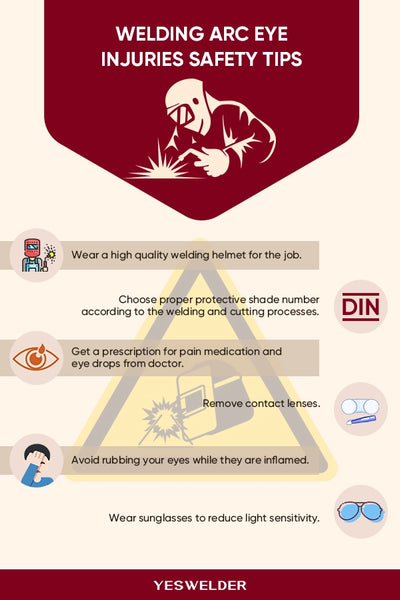
Squinting your eyes before striking an arc won't do the trick. But, wearing an adequate welding helmet will. There are several other crucial safety measures for eye injury prevention you should know, but let's first briefly discuss why the welding arc flash is so detrimental to your eyes.
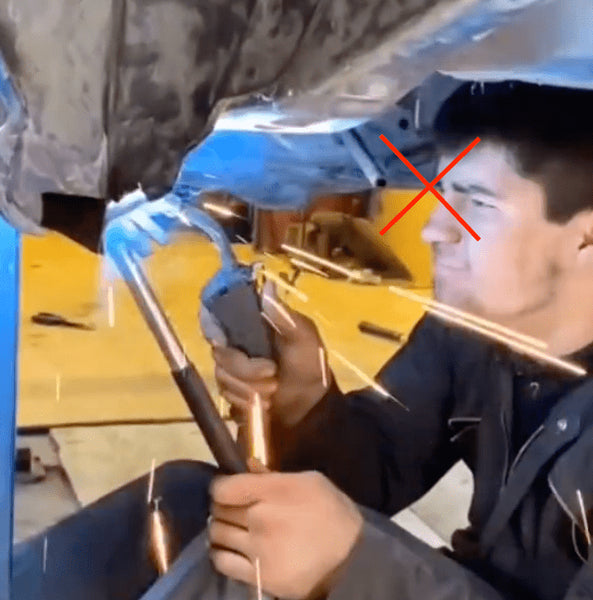
Photo by @builtnotboughtpod (TikTok)
How Welding Arc Flash Damages Your Eyes
Vision loss is difficult to treat, and oftentimes, there are no do-overs for getting your vision back. If you already have some vision loss, you know how precious eyes are and what it's like living with a reduced vision quality. But, if you have a perfect 20/20 vision, you should do everything in your power to keep it that way, especially in the welding line of work where it's vital to see a small puddle action clearly.

Welding arc produces powerful ultraviolet and infrared radiation, which can cause severe arc flash eye damage. This damage can be acute (temporary until it improves) or chronic (long-term eye and vision problems). In most cases, arc flash eye injuries are acute, so the symptoms will withdraw after temporary eye damage heals. But, every time your eyes are exposed to the welding arc, they are getting closer to developing long-term issues.
Repeated arc exposure can cause permanent vision reduction and eye damage. Long-term UV eye exposure can lead to the formation of cataracts and eye adaptation to intense visible light. The adaptation process can cause your eyes to try to ward off arc rays and change the pupillary reflex, shading of the eyes, and the diameter of pupil contraction.
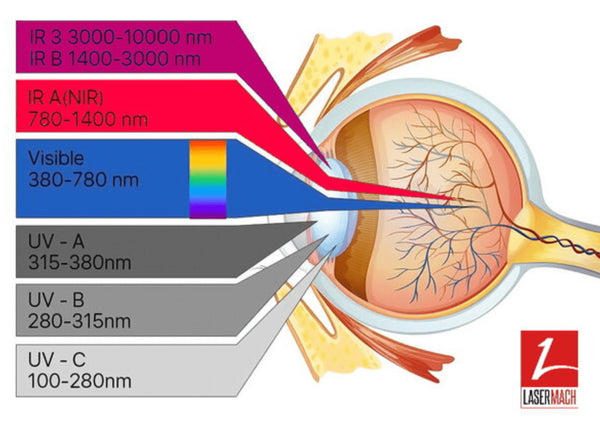
Source: https://photonweld.com/safety-health-at-laser-welding-protection-and-regulations-at-laser-welding/protection-for-your-eyes-against-laser-light-from-laser-welding
Acute arc damage causes severe eye pain that can last for several days. When the UV radiation reaches your eyes, the top layer of your eyes quite literally becomes sunburned. This condition is called photokeratitis, which is a sun-like burn of parts of your eye. Photokeratitis is often referred to as welder's flash or arc flash. This is the same type of eye injury you get when spending a significant amount of time in snowy mountains without UV-blocking goggles, which is why this condition is also referred to as snow blindness in the context of outdoor activities.

Source: https://blog.radwell.com/what-is-welding-arc-flash
Arc eye injury leaves the nerves of your cornea injured and exposed, which leads to intense pain and sometimes short-term impaired vision. Needless to say, every time you get photokeratitis, you are likely contributing to long-term vision and eye problems. Studies show that cumulative adverse effects of the welding arc can create corneal scarring and lead to a thin membrane over the eyeball to degenerate. Such eye damage can lead to long-term vision problems, eye pain, burning sensation, and light sensitivity.
Welding Arc Eye Injury Symptoms
You won't always feel acute arc eye injuries immediately. Symptoms may take up to 12 hours to begin. The first symptom to start is often the intense pain in one or both of your eyes, which can spread to cause a headache.
Other symptoms you may experience as a part of an acute welder's flash are:

Source: https://www.hseblog.com/welder-flash/
- Feeling of having sand or other foreign objects in your eyes even if there is nothing there.
- Impaired vision
- Red eyes that look bloody
- Facial redness
- Swollen eyelids
- Blurry vision
- Teary eyes
- Color changes in your vision
- Temporary loss of vision
- Seeing halos around light sources like traffic lights and street lamps
- Light sensitivity, also known as photophobia. It can cause strong headaches and make looking at anything bright very uncomfortable.

Source: https://www.verywellhealth.com/overview-of-photophobia-4586489
The amount of time needed for these symptoms to pass depends on the exposure length, distance from the arc, the arc intensity, and the kind of protection used (if any).
Treatment For Arc Flash Burn
Usually, acute arc flash injury doesn't require any specific treatment, as the eye will heal on its own. However, you should always visit an ophthalmologist or your prescribed physician just to be sure, as arc flash can cause other eye issues, like bacterial infections.
Your doctor may prescribe an antibiotic ointment to prevent the possible infection. Likewise, you may get a prescription for pain medication and eye drops. If you wear contact lenses, it's a good idea to avoid putting them in your affected eye until your cornea heals to prevent irritation.
Avoid rubbing your eyes while they are inflamed, as this can cause corneal scarring and prolong the injury healing phase. Wear sunglasses to reduce light sensitivity until your eyes heal and become less sensitive to bright light.
Preventing Welding Arc Eye Injuries
The best way to prevent welding arc eye injuries is to wear an appropriate welding helmet for the job at hand.
High quality welding helmets protect you from harmful UV and IR radiation. For example, our YesWelder LYG-Q800D provides a DIN 16 protective shade from UV and IR radiation, which is among the highest in the industry.
LYG-Q800D Panoramic View Auto Darkening Welding Helmet
The table below shows the Occupational Safety And Health Administration and American Welding Society's recommended protective shade number according to the welding and cutting processes. We highly recommend using the minimum of these numbers for your hobby and professional welding applications.
|
Welding/Cutting Process |
Arc Amperage Current |
OSHA Minimum Protective Shade |
AWS Recommended Shade |
|
Shielded Metal Arc Welding (SMAW) |
Below 60 |
7 |
- |
|
60-160 |
8 |
10 |
|
|
160-250 |
10 |
12 |
|
|
250-550 |
11 |
14 |
|
|
Gas Tungsten Arc Welding (GTAW) |
Below 50 |
8 |
10 |
|
50-150 |
8 |
12 |
|
|
150-500 |
10 |
14 |
|
|
Gas Metal Arc Welding (GMAW) |
Below 60 |
7 |
- |
|
60-160 |
10 |
11 |
|
|
160-250 |
10 |
12 |
|
|
250-500 |
10 |
14 |
|
|
Flux-cored Arc Welding (FCAW) |
Below 60 |
7 |
- |
|
60-160 |
10 |
11 |
|
|
160-250 |
10 |
12 |
|
|
250-500 |
10 |
14 |
|
|
Plasma Arc Cutting |
Below 300 |
9 |
12 |
|
300-400 |
10 |
14 |
According to the American Academy of Ophthalmology, there are about 20,000 reported eye injuries in the workplace every year. But, The Welding Magazine reports a significantly higher number of 365,000 victims of work-related eye injuries each year in the United States. This number includes arc flash, chemical, and physical eye injuries. So, while it's essential to protect yourself from the arc radiation, you should also wear safety glasses underneath the welding helmet.

Source: https://safevision.com/blog/common-eye-injuries-and-costs/
Choosing a Quality Welding Helmet
Okay. So, I should be wearing the welding helmet at all times when welding, right?
Yes. As long as the arc is lit, you need to be protected using the welding helmet shade lens.
However, not every welding helmet will protect you the same. First, passive welding helmets are outdated for modern welding needs. Second, they force you to lift the hood up and down all the time while you work, making it more likely that you'll accidentally flash yourself.
Auto-darkening welding helmets are much better as they auto-darken as soon as their sensors detect the radiation coming from the welding arc. But, high quality helmets, like our YesWelder auto-darkening welding helmets, also include PASSIVE protection. So, if something is ever wrong with the helmet, you are protected from UV/IR radiation regardless if the auto-darkening filter was turned on.
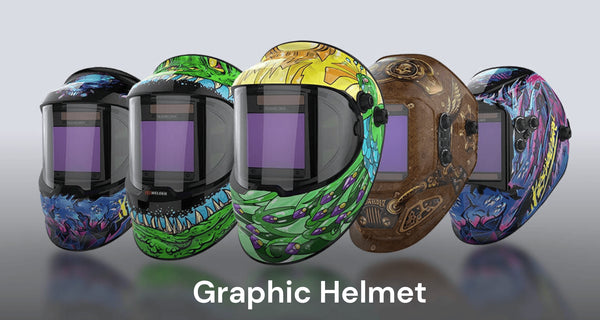
Source: https://www.shopyeswelder.com/collections/custom-graphic-helmet-sale
YesWelder auto-darkening welding helmets let you adjust the auto-darkening filter (ADF) shade to match the amperage output, as noted in the table. Likewise, you can adjust the sensor sensitivity so your helmet responds to the environmental light. Our helmets have EXTREME response times. Some of our models can respond to an arc in less than 1/30000 of a second. So, the ADF will darken as soon as the arc is established.
While your welding helmet is an absolutely crucial piece of protective equipment, it doesn't have to be dull! Some people like minimalistic design, and we have plenty of those helmets too. But, we collaborated with artists to create a series of graphic auto-darkening hoods that match everyone's style. So, whether you like a minimalistic approach, or you want a monster of a hood, YesWelder has got you covered!
LYG-L500A-OM Franky Customize Graphic Monster Auto-darkening Welding Helmet
Ensuring Others In the Welding Area Are Safe From Arc Flash
Wearing an adequate welding helmet protects YOU from the welding arc. But, others in the work area need to be protected as well. If you are a solo rider in your shop, you've got nothing to worry about here. But, if you've got some helping hands or your garage is opened for others to accidentally sneak a peek at your welding arc, you'll need to shield the observing eyes.
The Welding Institute reports that the US Army has carried out trials which propose that an arc exposure of 10 minutes at a distance between 3 and 20 meters is below the daily threshold limit value. However, many other sources indicate that no arc exposure is safe for your eyes. Therefore, we highly recommend that everyone working with you has a welding helmet or is protected by a welding screen separating the working area.
It's also recommended to put up warning signs of welding-related work in front of your garage or the shop. So, if any unsuspecting person wants to enter, they should expect you welding inside and be mindful of not looking directly at the arc.
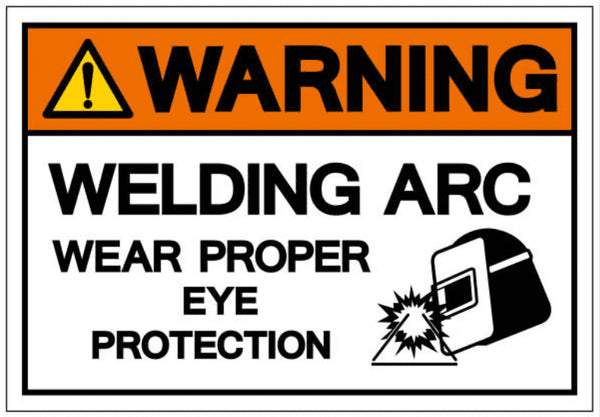
Conclusion
While welding is a hazardous trade, steps can be taken to dramatically limit the possible health issues. With the proper personal protective equipment and mindful, safe practices, you can have a long and prosperous welding career without any negative work-related health issues. After all, hundreds of thousands of welders are in the active workforce, and not all of them suffer from acute or chronic illnesses.
Be sure to check out our welding fumes hazards guide on protecting yourself from the harmful welding evaporations coming off your base metal and the electrodes. Likewise, check our guide on preventing electrical shocks in welding to understand the dangers and how our VRD equipment can help prevent electrocution. Stay safe, and feel free to contact our support for help with choosing any of our PPE or welding equipment.
🧐Welding Arc Eye Injury Prevention - Welding Safety Tips- FAQ
1.What are welding arc eye injury symptoms?
The initial symptom of acute welder's flash is intense eye pain, possibly affecting both eyes and leading to headaches. Additional symptoms include a sensation of foreign objects in the eyes, impaired vision, red and swollen eyelids, blurry vision, teary eyes, facial redness, temporary loss of vision, color changes in vision, halos around light sources, and light sensitivity (photophobia), which may cause discomfort and headaches when exposed to bright light.
2.How to prevent welding arc eye injuries?
To prevent welding arc eye injuries, it is essential to wear a suitable welding helmet, such as the YesWelder LYG-Q800D, which offers a high-quality DIN 16 protective shade against UV and IR radiation. Following the recommended protective shade numbers by the Occupational Safety And Health Administration and American Welding Society for various welding and cutting processes is crucial. It is highly advisable to use at least the minimum recommended shade number for both hobbyist and professional welding applications.
👏 You may be interested in the following:
- MIG welding wire types
- How Pulsed welding works
- How To Setup And Use Your MIG Welder For The First Time






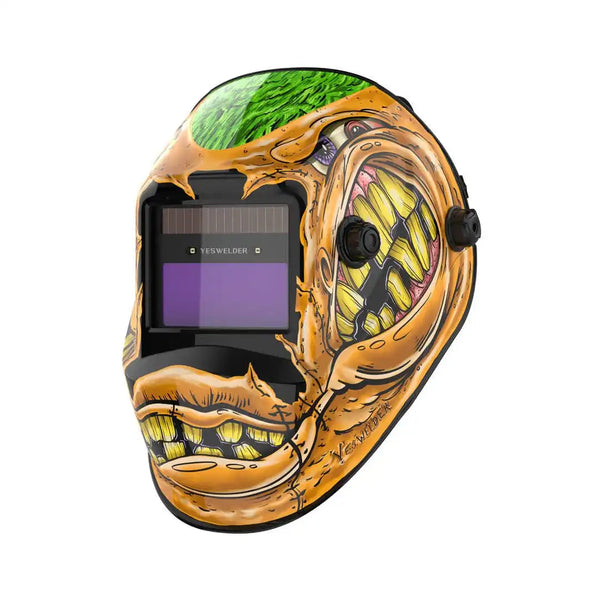


Leave a comment